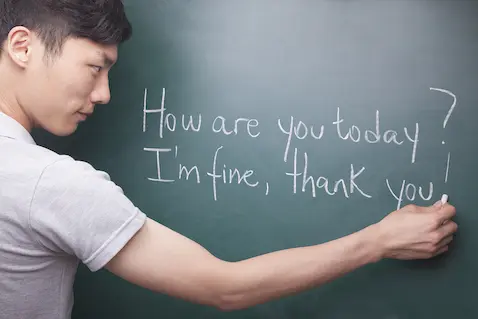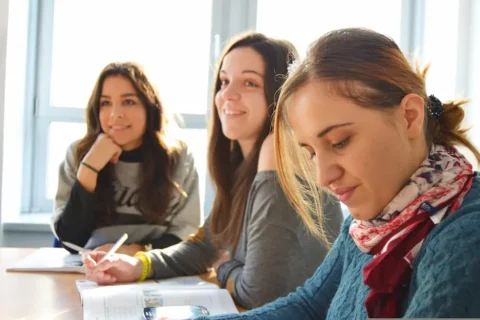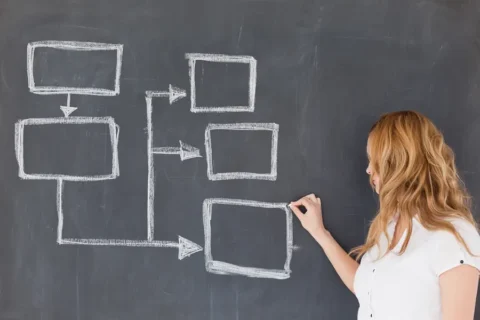Teaching English isn’t just about standing at the front of the room and talking – and it shouldn’t be. A learner-centred classroom shifts the focus from you to your students, making them active participants in their learning. That’s when real progress happens: when students feel engaged, take ownership, and connect what they’re learning to their own lives.
Here are four practical ways to make your ESL classroom more learner-centred.
1. Personalise Your Lesson
This is one of the most effective things you can do as a teacher. The more you can make the topic, the individual activities, and the examples you use relevant and personal to the learners, the better. This doesn’t just mean choosing a topic they’re interested in (although that’s important). It means involving their own experiences in the entire structure of the lesson. Here’s an example to show what I mean, taken from this lesson teaching “used to”.
The lead-in to the lesson shows some photos of children doing typical childhood activities. The idea is to use these as examples of things we used to do as children but don’t do now. A non-student-centred instruction for this activity might be: “Look at these pictures – what are the children doing? Do we do these things as adults?”
Instead, we say: “Did you do these things in the past, and do you do them now?” After that, students write down three more things they did in the past but don’t do now. (We keep these aside for later in the lesson.)
This simple shift, from “the children” to “you” immediately puts the students at the centre of the lesson, rather than just discussing generic childhood activities in a detached way.
This continues in the next activity, which pre-teaches vocabulary for a listening exercise. We pre-teach words like “addict,” “addiction,” “to quit,” “to give up,” “to cut down on,” and “willpower” with the help of pictures of coffee, cigarettes, and chocolate. Again, a non-student-centred approach would involve looking at the pictures and asking: “What do we call someone who uses this all the time and can’t stop?”
Instead, we make the very simple shift and say: “Discuss in pairs whether or not you use these things, how often, and whether you can stop using them if you want to.” It’s a subtle shift, but immediately more engaging because they’re talking about their own experiences.
Later in the lesson, once the target language “used to” has been presented, we bring the lesson full circle. We use the three things students wrote at the beginning. We write some of them on the board and have students circulate, asking each other whether they used to do these things, with the aim of matching the things to the students. They’re encouraged to ask follow-up questions. Again, the practice isn’t some generic, impersonal activity – it’s using their own experiences to converse using the target language. Much more engaging, much more personalized, much more student-centred – and it makes the lesson feel cohesive.
I can’t emphasise enough what a difference this can make to your lessons. It’s a subtle shift, and may seem obvious, but once you start thinking of ways to do it in each lesson, it becomes easier and more natural.
Here’s an example of a listening activity which uses this same personalised approach.
Next – three more general tips for making you lessons more student-centred:
2. Start with What They Already Know
Use your students’ existing knowledge – just like you use their existing experience in the point about personalisation above. Your students already know more than they think – and more than they give themselves credit for. Help them see that by connecting new material to what they already know right at the start of a lesson.
This could mean reviewing and consolidating “past simple” before moving on to compare it with “present perfect” – a confidence builder. Or brainstorming vocabulary rather than just giving it to them – let them add words to your list on the board. Or play a short video related to your topic as a lead-in and ask what they already know about it. Activating their existing knowledge makes them more engaged and motivated.
3. Give Students Choices
Nobody likes being told what to do all the time – your students included. Even small choices make them feel more invested and motivated.
For example:
- Let students choose whether to write an email or give a short presentation.
- Offer easy, medium, and challenging versions of the same task – and let them pick.
- Let them decide whether to work alone, in pairs, or in small groups.
- Have them vote on which topic, theme, or language point to cover next week.
When students feel like their opinions matter, they work harder and take more ownership.
4. Help Them Organise Their Ideas
Give your students tools to organise their ideas and what they’re learning. This can help prevent overwhelm and empower your students. For example:
- Mind maps: connect new words to what they already know.
- Story maps: simple visual organizers that help students plan and retell a narrative by laying out its key parts in order, e.g. beginning, problem, events, resolution.
- Venn diagrams and tables: compare and contrast two grammar points, lexical sets (a group of words that share a common feature), or opinions.
Final Thoughts
You don’t have to completely change the way you teach to create a learner-centred classroom. Start with just one or two of these strategies and build from there. You’ll notice your students becoming more engaged, more confident, and more independent.
And you’ll probably find yourself enjoying your lessons more too.









1 comment
daguiani mohamed
Thank you very much for this interesting topic. Nowadays the learner is viewed as the central element in the process of learning and teaching. A few days ago I participated in the exam of doctorate (TEFL) and we were given a question about the shift of focus from the teacher to the learner; and its effects on the foreign language teaching methodology. If I had read this article before I could have developped it better in the exam!